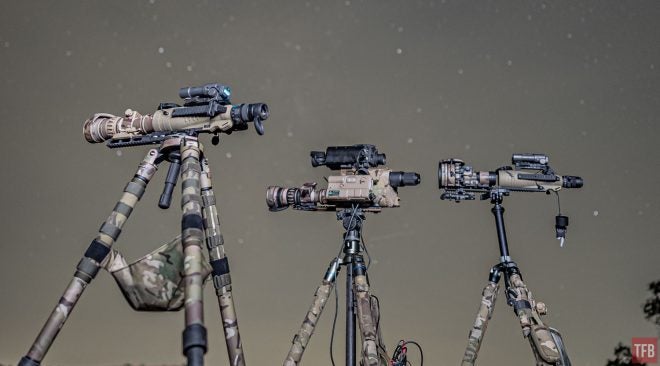Good afternoon and welcome back to another edition of the Friday Night Lights series. Today we will show and tell about tricked-out spotting scopes. These spotting scopes have been set up for nighttime observation with a bunch of accessories. As always, the Friday Night Lights series is brought to you by ATN Corp, manufacturers of night vision and thermal optics like the THOR LT. As with all of our sponsored series, Friday Night Lights will continue to bring you unbiased news and reviews from a variety of companies.
Long-range Night Vision @TFB:
- Friday Night Lights: Magnum Universal Night Sight (MUNS) PVS-27
- Review: Knights Armament Co. AN/PVS30 Clip-On Night Vision
- Friday Night Lights: Long Range IR Illuminators – LN-ELIR-3 and SPIR
Choosing A Spotting Scope To Trick Out
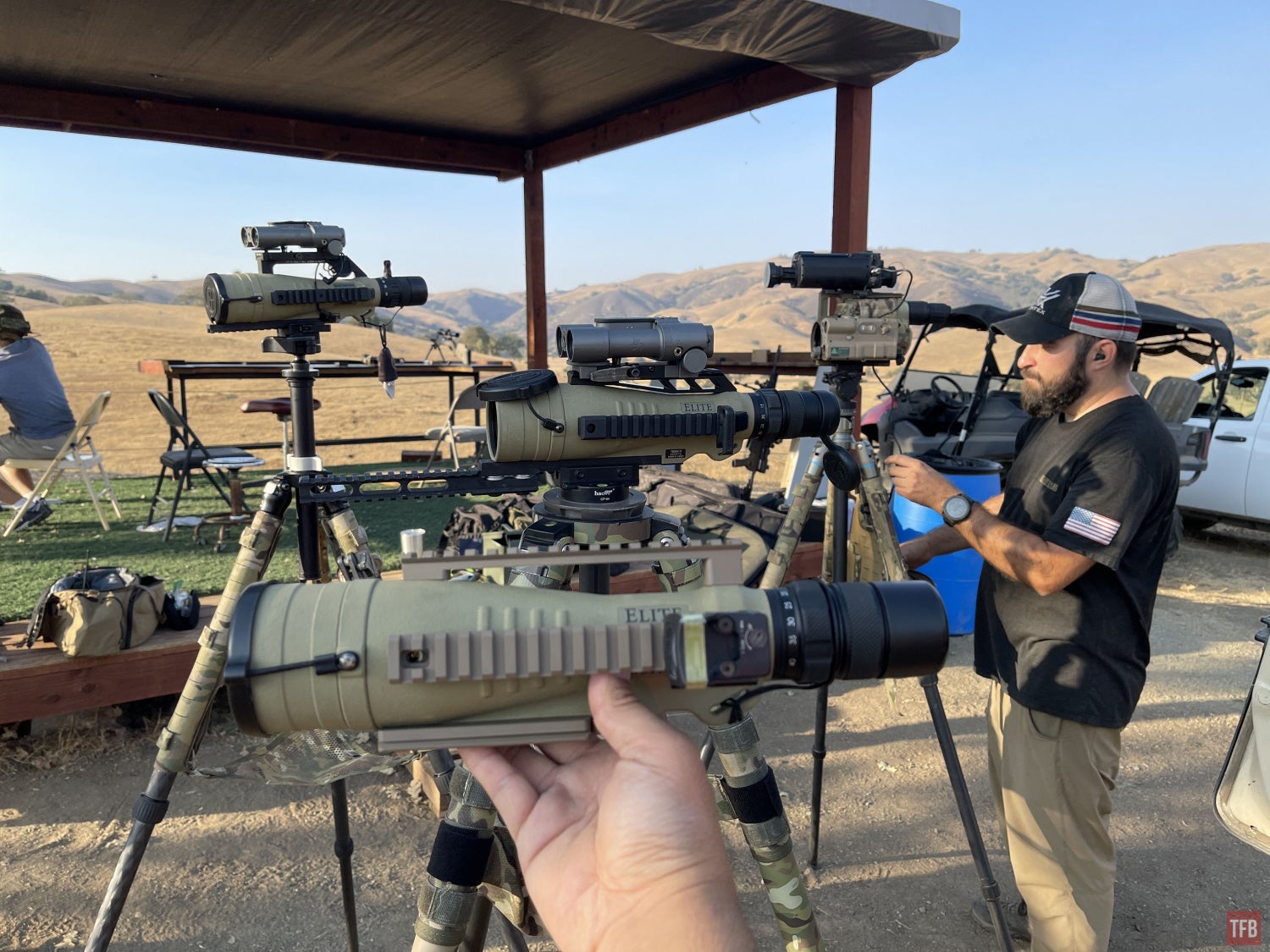
Above is a picture of some tricked-out spotting scopes. As you can see, there are really only two models pictured. In the world of spotting scopes, there are not a lot of options regarding “tactical spotting scopes”. What constitutes a tactical spotting scope that is a good candidate for tricking out? Rails. Lots of rails. But rails are only the first step. In order to add accessories to spotting scopes, you need a way to attach them. In no particular order here is a list of spotting scopes that you can get.
- Bushnell LMSS
- Bushnell LMSS 2
- Bushnell Legend Tactical
- Athlon Cronus Tactical
- Leupold MK4
- Hensoldt 45/60
The Bushnell LMSS, Legend Tactical and Athlon Cronus come with Picatinny rails already mounted to the spotting scope body.
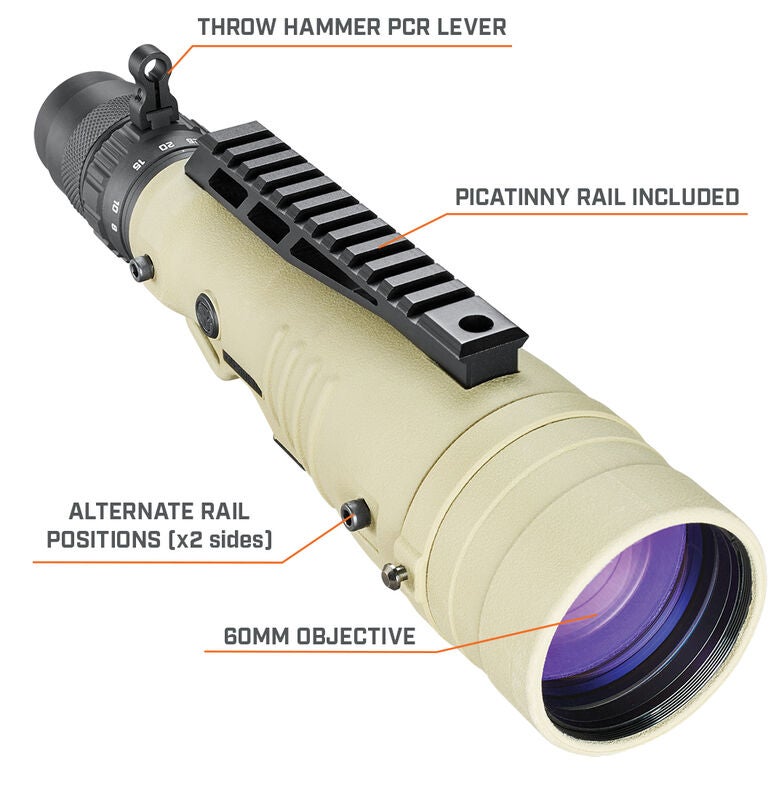
Photo by Bushnell
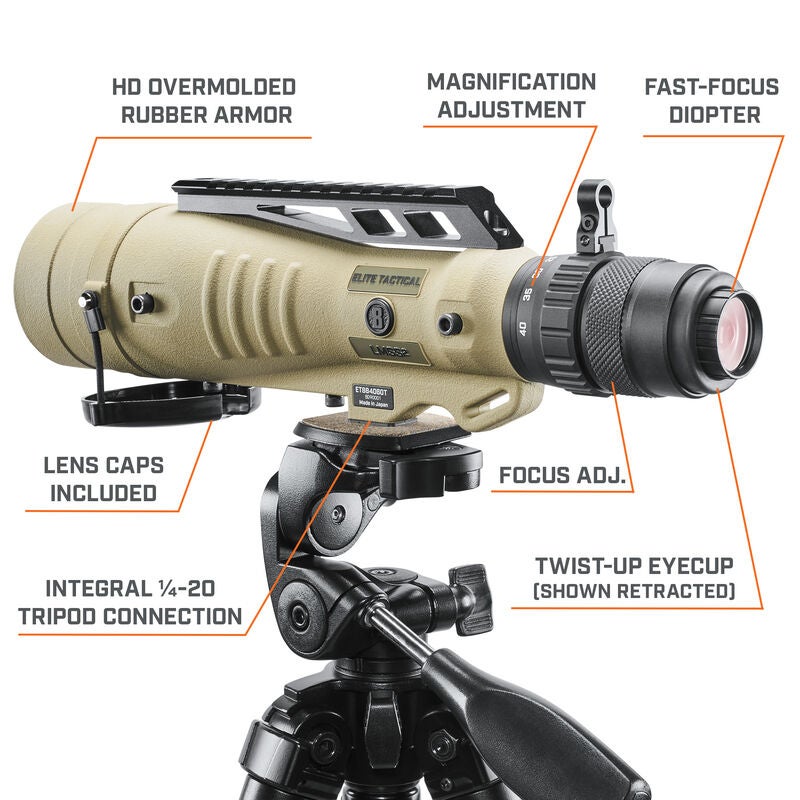
Photo by Bushnell
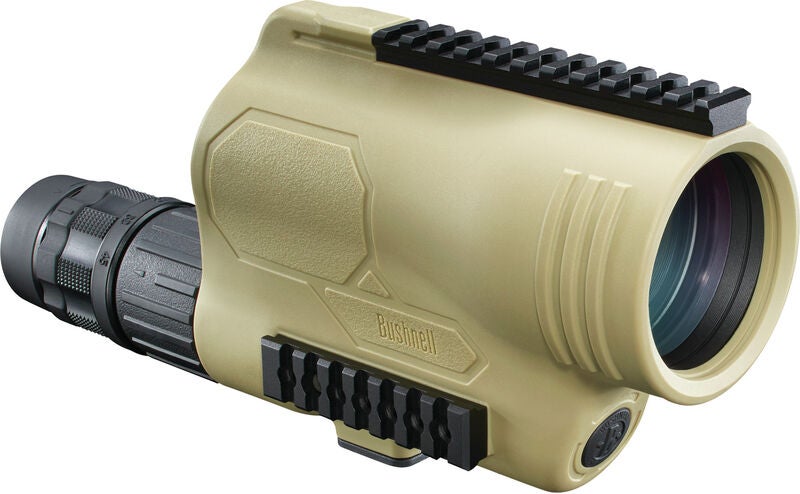
Photo by Bushnell
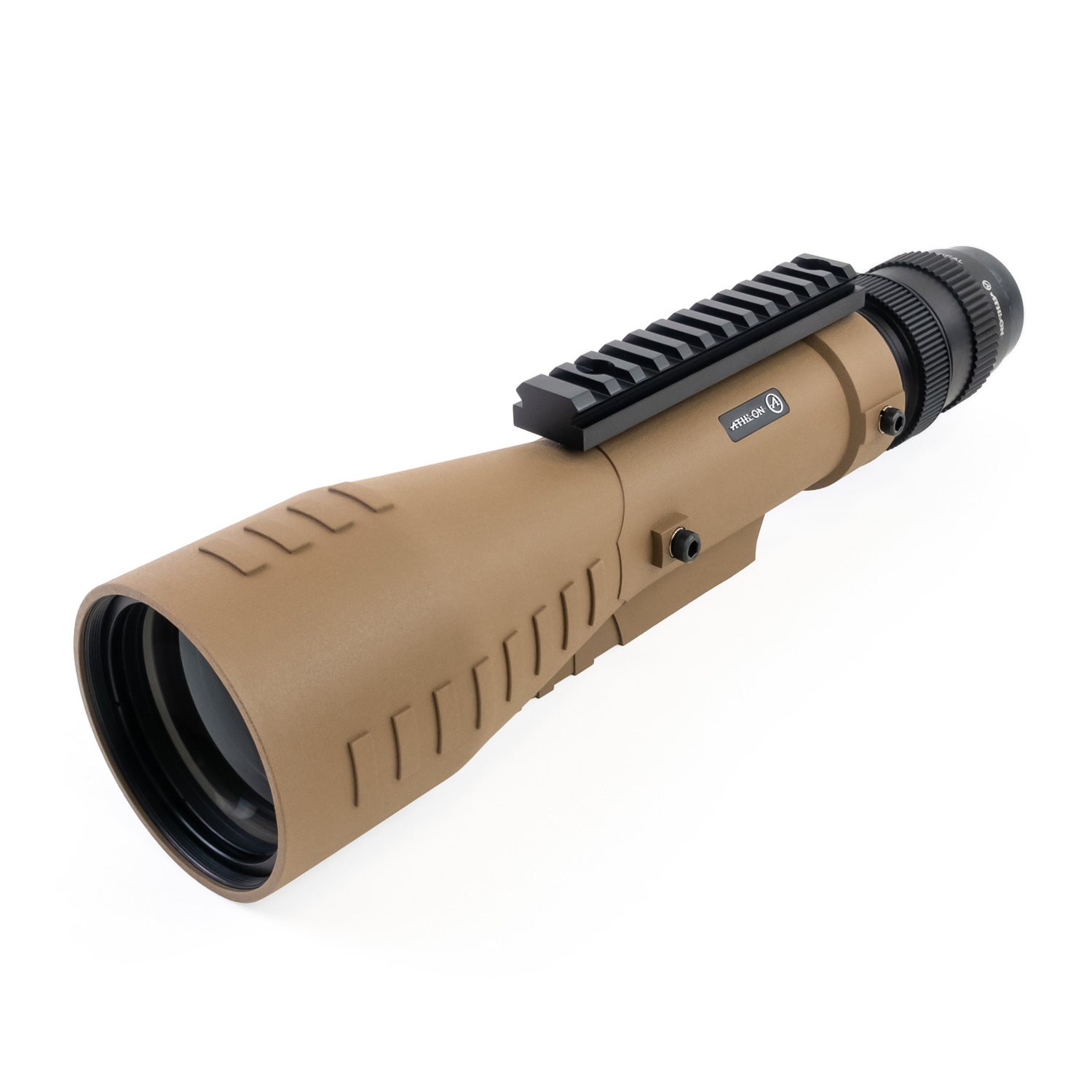
Photo by Athlon
Other than the Bushnell Legend Tactical, the other spotting scopes only come with a single Picatinny rail. The original Bushnell LMSS and Athlon Cronus Tactical are discontinued. While I am not sure about the Cronus rails, Bushnell does not sell additional rails for the LMSS or the LMSS2. I will go into that more later.

Photo by Leupold
The other spotting scopes on my list are the Hensoldt 60/45 and Leupold MK4. Both of these do not have rail systems but you can get some to build a tricked-out spotting scope. These are rather high magnification and start at 12x for the Leupold and 15x for the Hensoldt. Whereas the Bushnell LMSS starts at 8x and the Cronus Tactical starts at 7x. The lower magnification is better suited for night vision clip-ons.
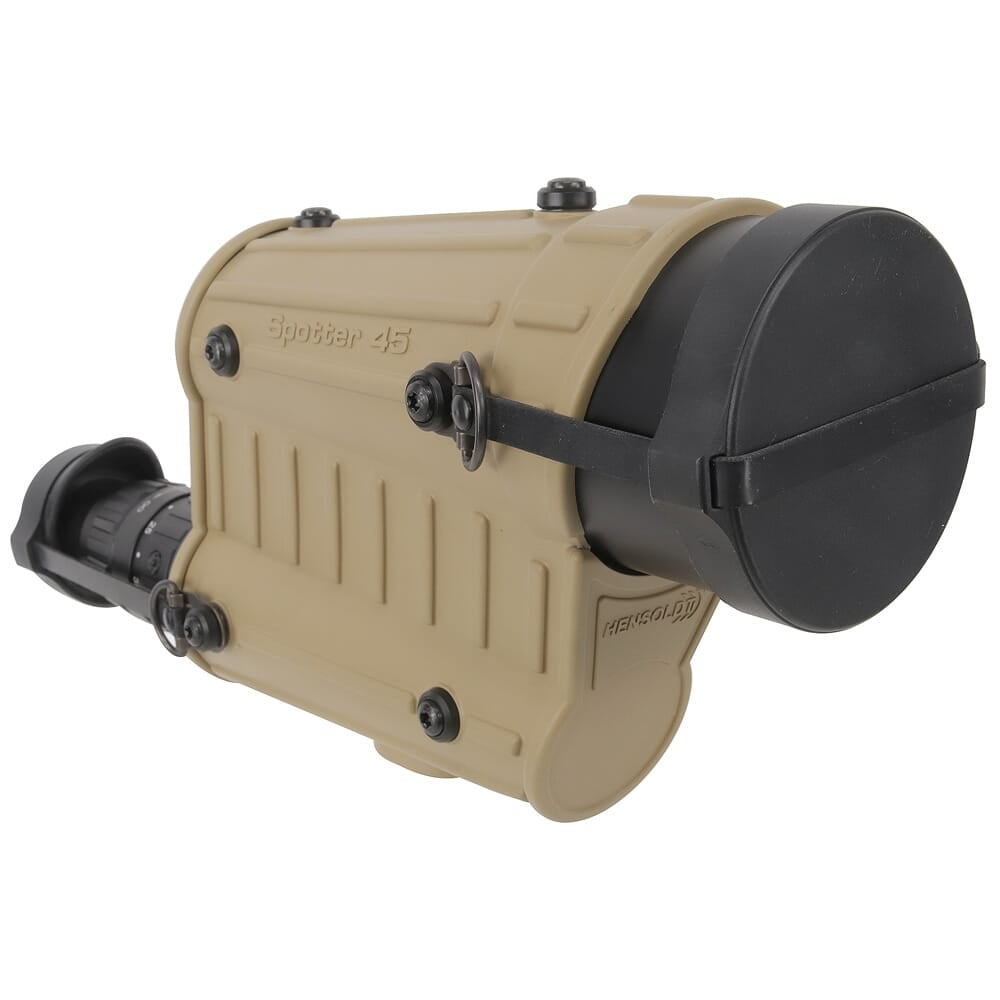
Photo by EuroOptic
Price may help you choose a spotting scope but if you want to use these in the dark, price may not be the priority. The cheapest out of these spotting scopes is the Bushnell Legend Tactical. Bushnell has it listed on their website for $619.99. The next affordable tricked-out spotting scope would be a used Bushnell LMSS or Cronus Tactical. I picked up my used Bushnell LMSS for $900. This is better than buying a brand new LMSS 2 for double the price. The Leupold MK4 starts out at $1,699. And the king of price is the Hensoldt Spotter 45/60 which retails for $4,330 on EuroOptic.
Tricked Out For Accessories
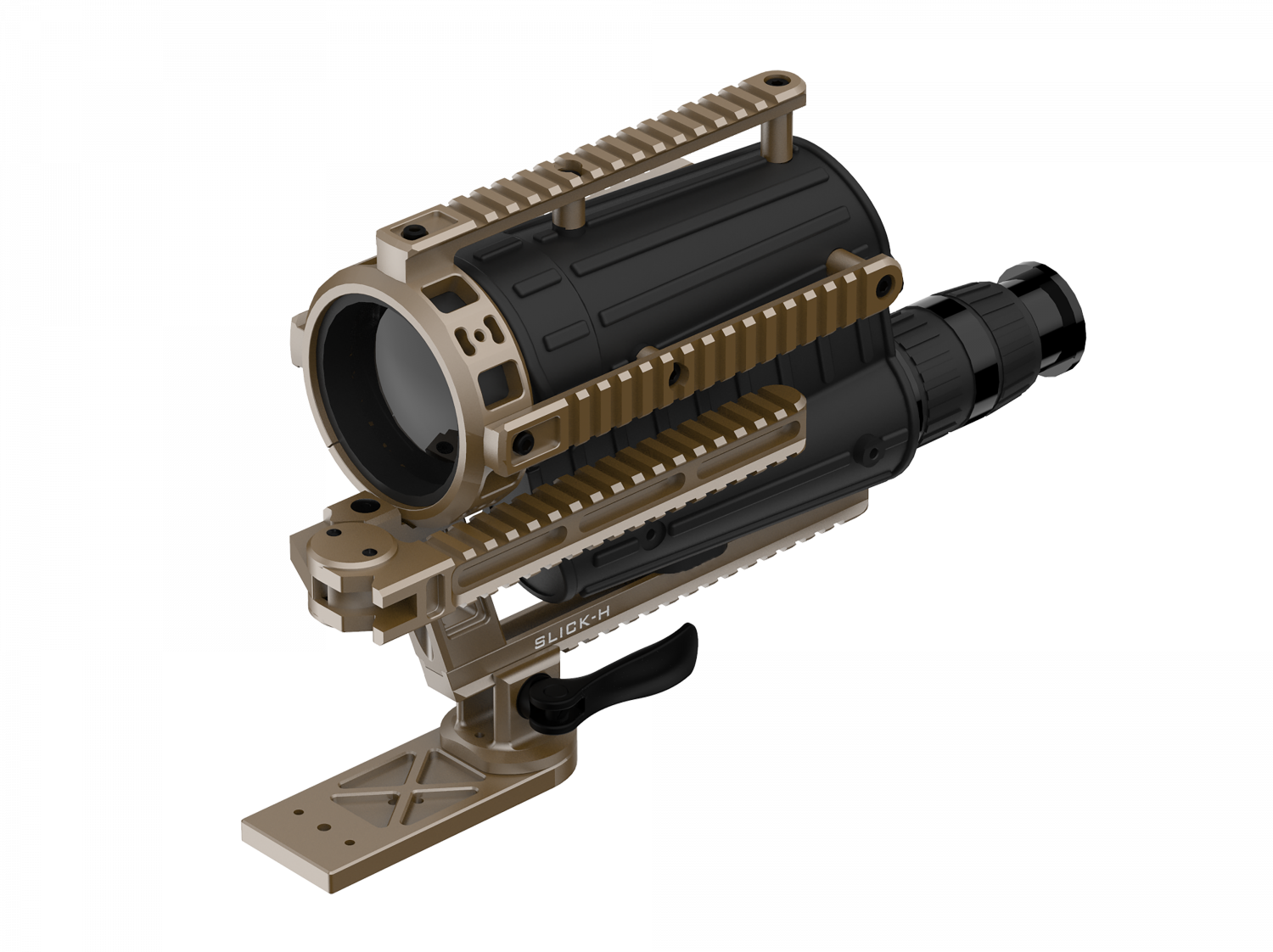
For people who have the Leupold MK4 or Hensoldt, you can get a Badger Ordnance S.L.I.C.K. (SNIPER LIGHTWEIGHT INTEGRATOR COMBAT KIT) This allows you to attach almost any accessory you could want.
They used to make a simpler version.

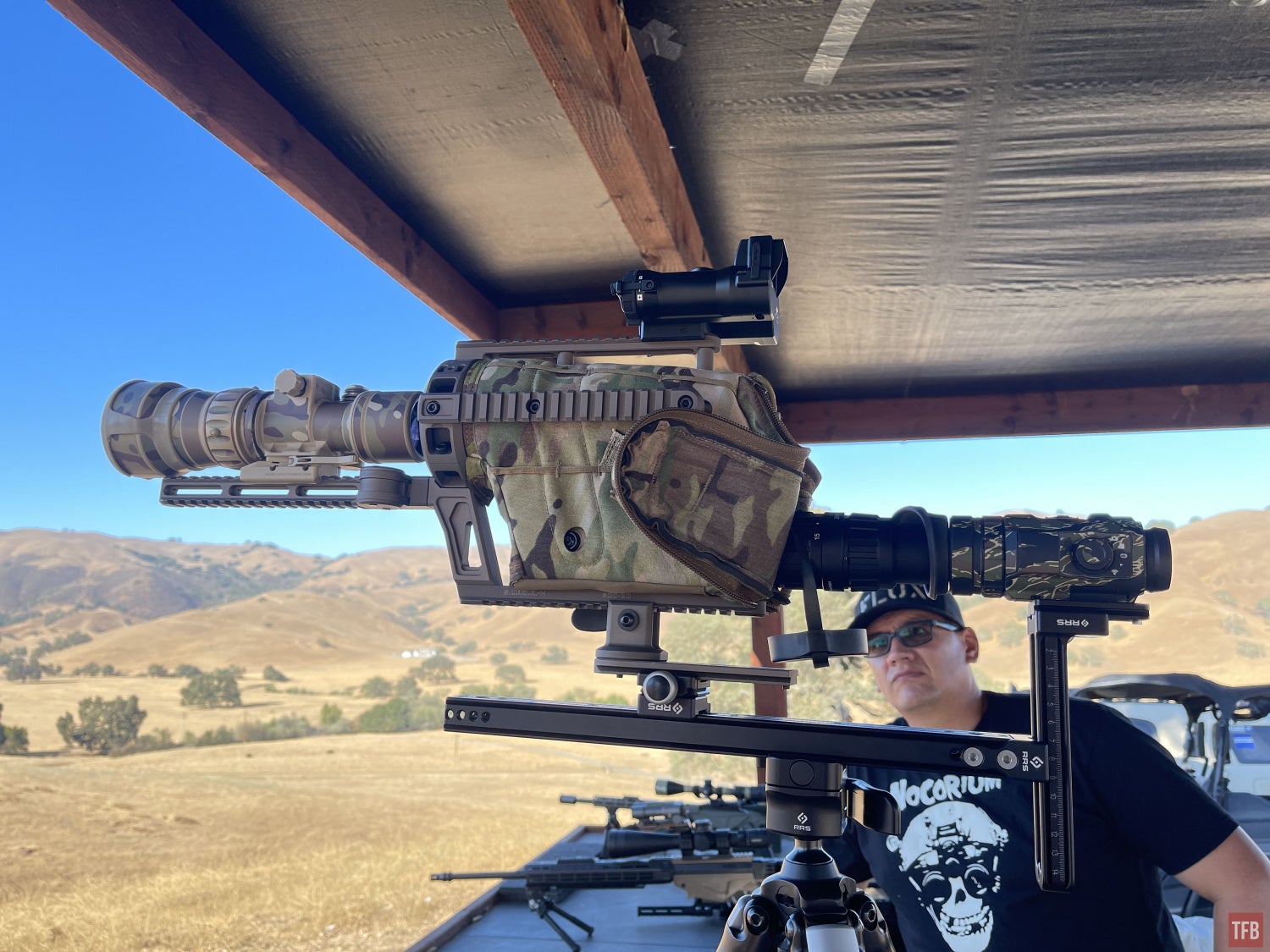
Another option for the Leupold MK4 is the Kinetic Development Optics HUB. It is a metal shroud that covers the entire spotting scope.
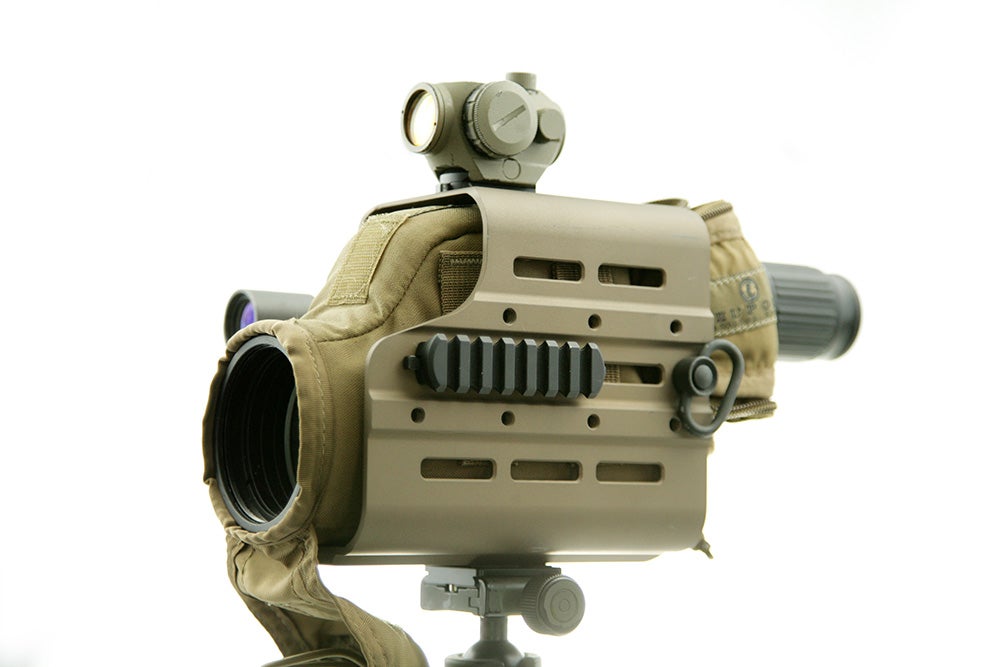
My friend Jayden of VG6 Precision made a sort of saddle system for the Athlon Cronus Tactical spotting scope. See his tricked-out Cronus below.
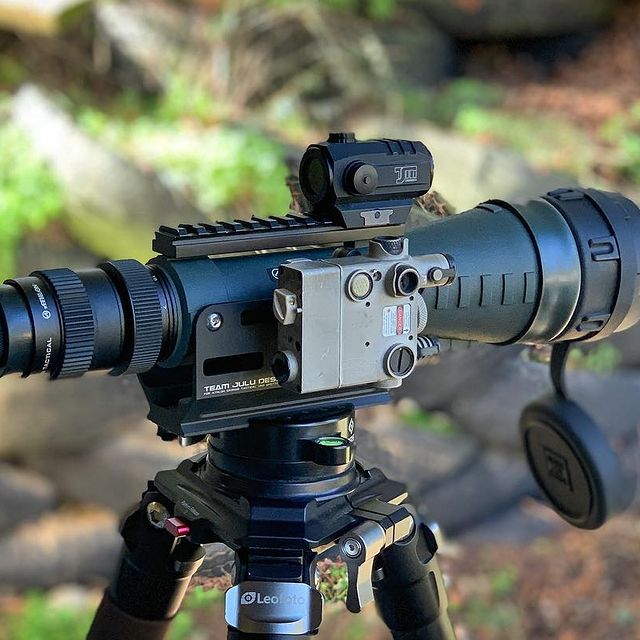
Photo by Jayden
His spotting scope saddle bolts to the side anchor points for the side rails. This gives him M-LOK slots to attach rails and various accessories. He designed the bottom of the saddle to have an integrated ARCA dovetail to mount to his tripod.
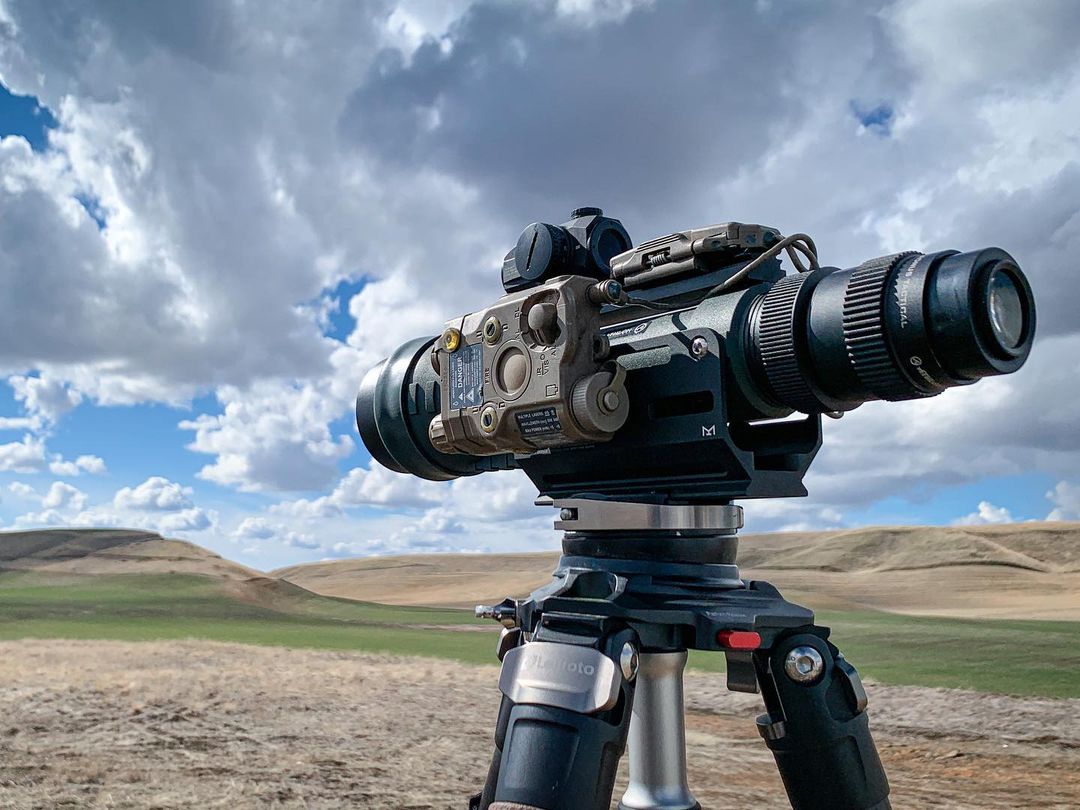
Photo by Jayden
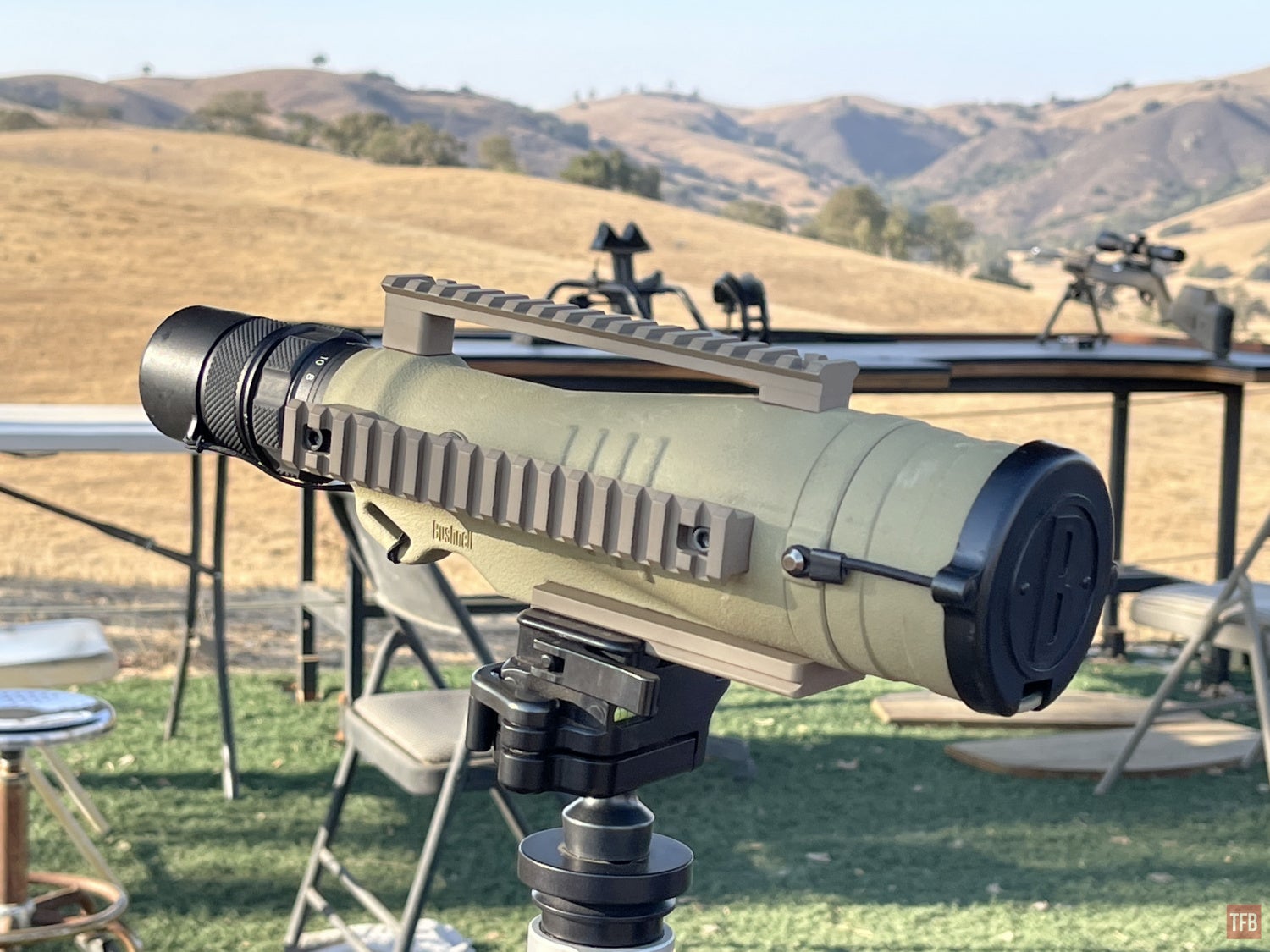
If you opt for the Bushnell LMSS, you have a couple options to get accessory rails. In the photo above, my friend Kythe’s LMSS has been upgraded with rails by Department Of Techne. He mounted three Picatinny rails and their ARCA rail on the bottom for mounting onto his tripod.
Another option is to go with Badger Ordnance to upgrade your Bushnell LMSS. Their Arc Light gives you rails and a taller top rail with a built-in mount for a cosine indicator.
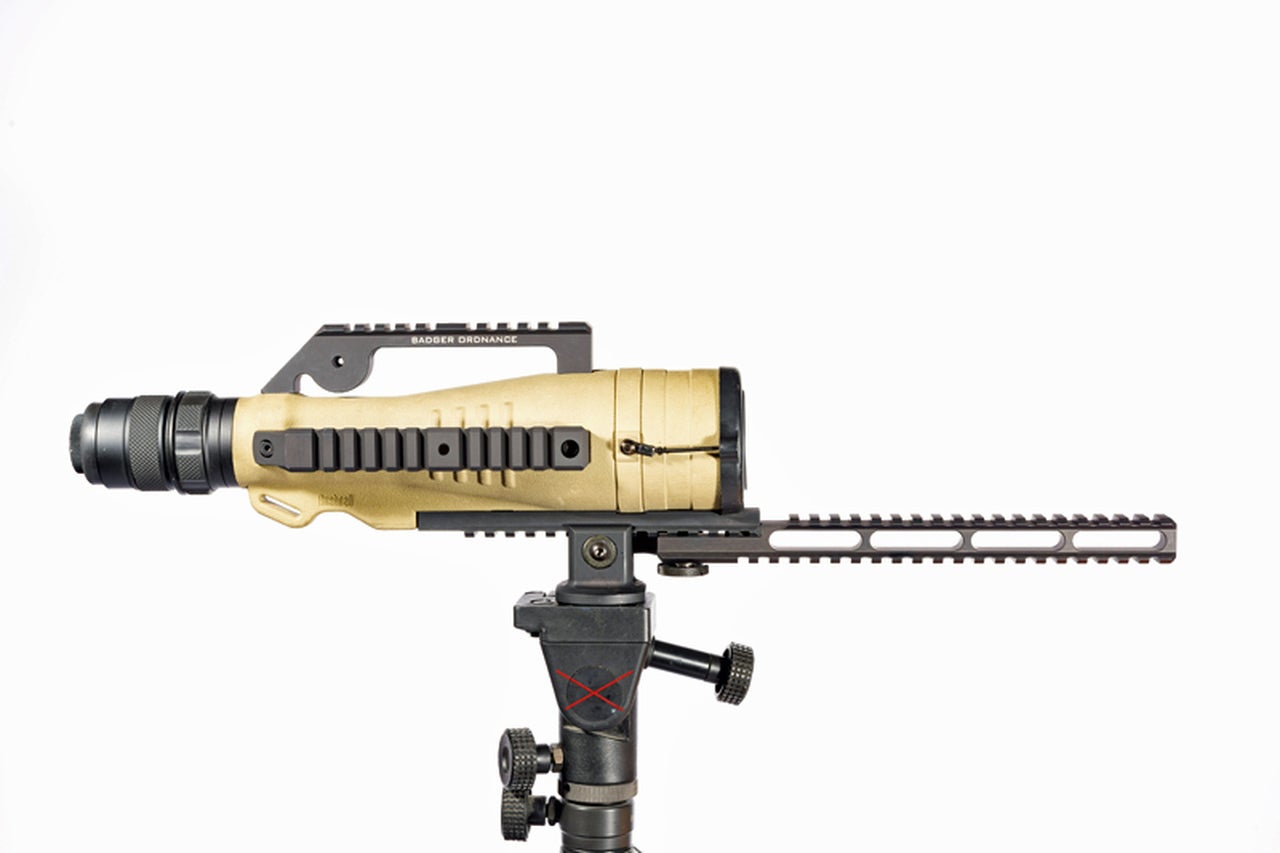
I bought Larue’s night vision rail since my LMSS came with two rails already on it.
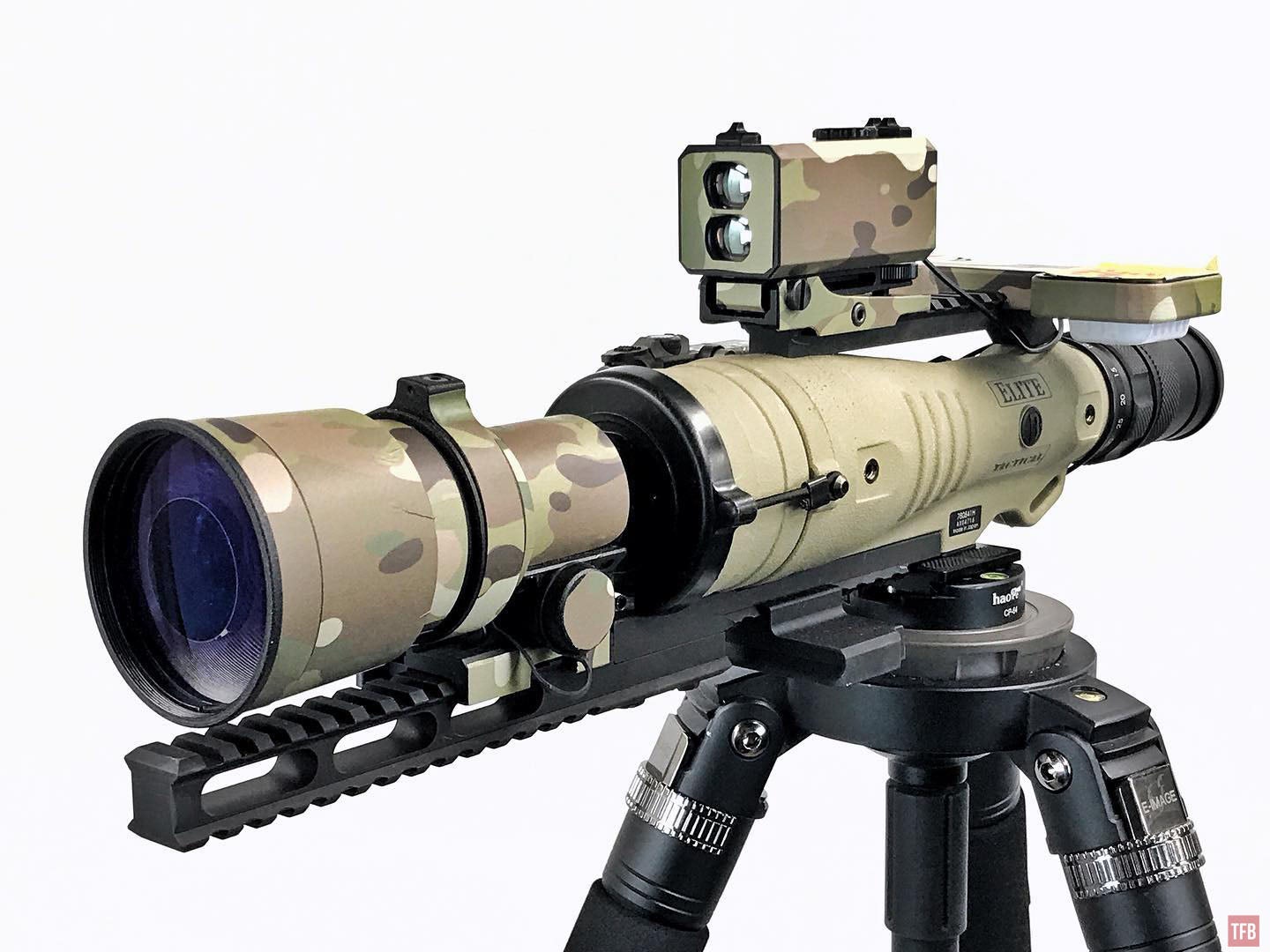
Spotting Scope Accessories
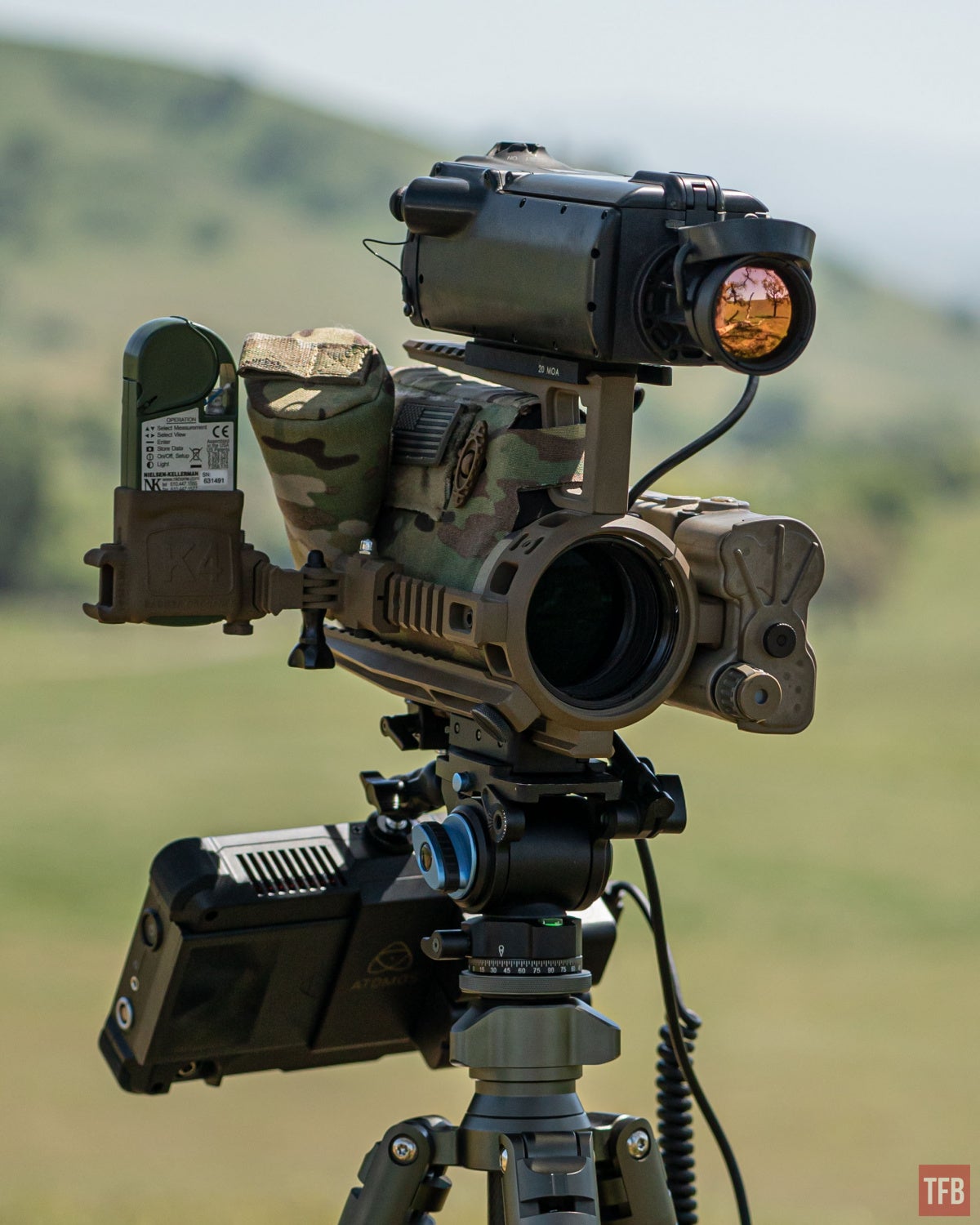
Now you have chosen your spotting scope, let’s build a tricked-out spotting scope. The accessories you want or need are determined by what you want to achieve with said tricked-out spotting scope. Many of these accessories can translate to daytime use while some are distinctly for nighttime use.
Here is a list that can work for most spotting scopes, assuming you have a method of attaching them.
- laser rangefinder
- red dot
- kestrel holder
- laser illuminator/pointer
- thermal camera
- clip-on night vision
Rangefinding
When it comes to a rail-mounted laser rangefinder, unfortunately, there are few options and even fewer are affordable. I found this Chinese laser rangefinder on Amazon that ranges out to 800 yards. The Laserworks laser rangefinder is only $200. It has a small LCD display and a remote tape switch. Most importantly, it can mount to a Picatinny rail and you can zero the IR laser pulse to your spotting scope with a night vision clip-on.

Another option is the SilencerCo/SWR Radius but it is long since discontinued. You can typically find them for around $1000 used.
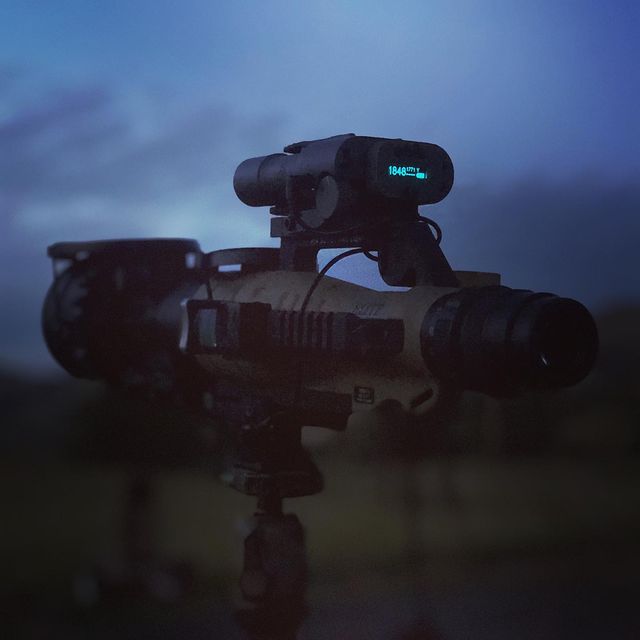
Photo by Kythe

Radius on my 10x PVS-7 lens.
Another option is the Wilcox Raptar but those are anywhere from $7k-$8k. They are more for weapon use since they have IR illuminators, IR lasers and an LRF that emits a pulse that is out of the band for night vision and even digital night vision.
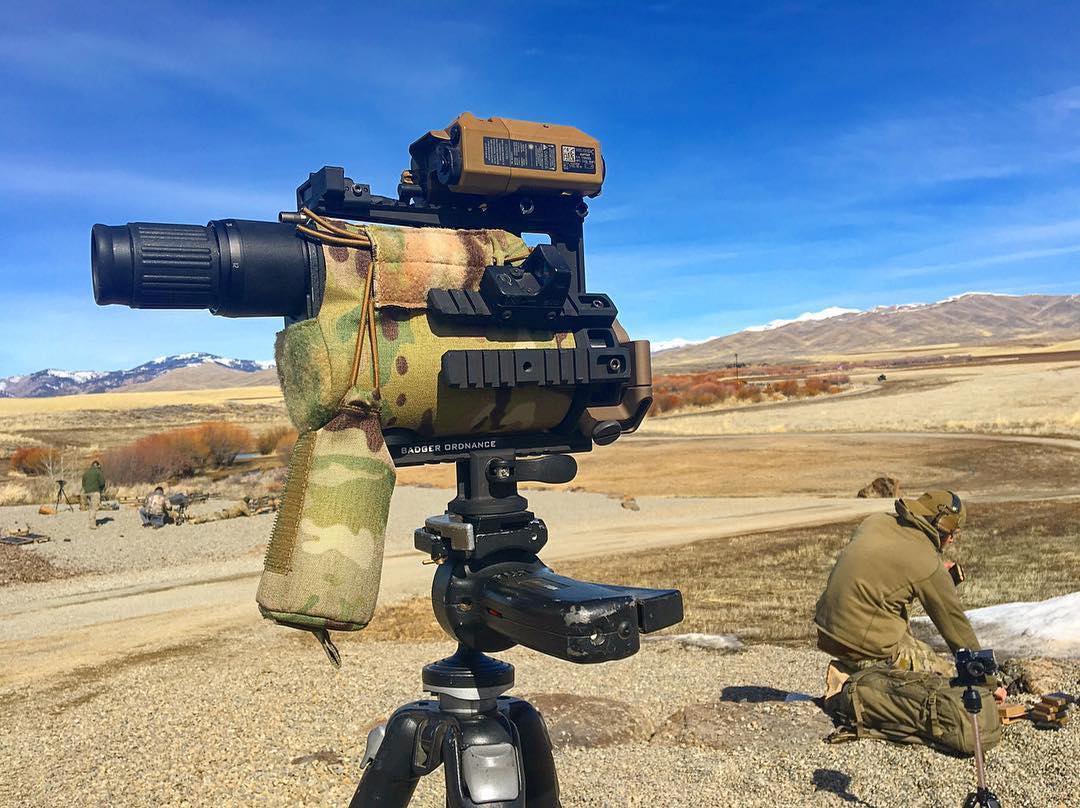
Photo by Badger Ordnance
For those who have access to them, like my friend Vic, he runs an L3 STORM (Small Tactical Optical Rifle-Mounted) micro laser rangefinder. It is a bit overkill and can range out to 10k meters. It is sort of like a PEQ-15 on steroids with a lot more capability with firing solutions for larger ordnance.
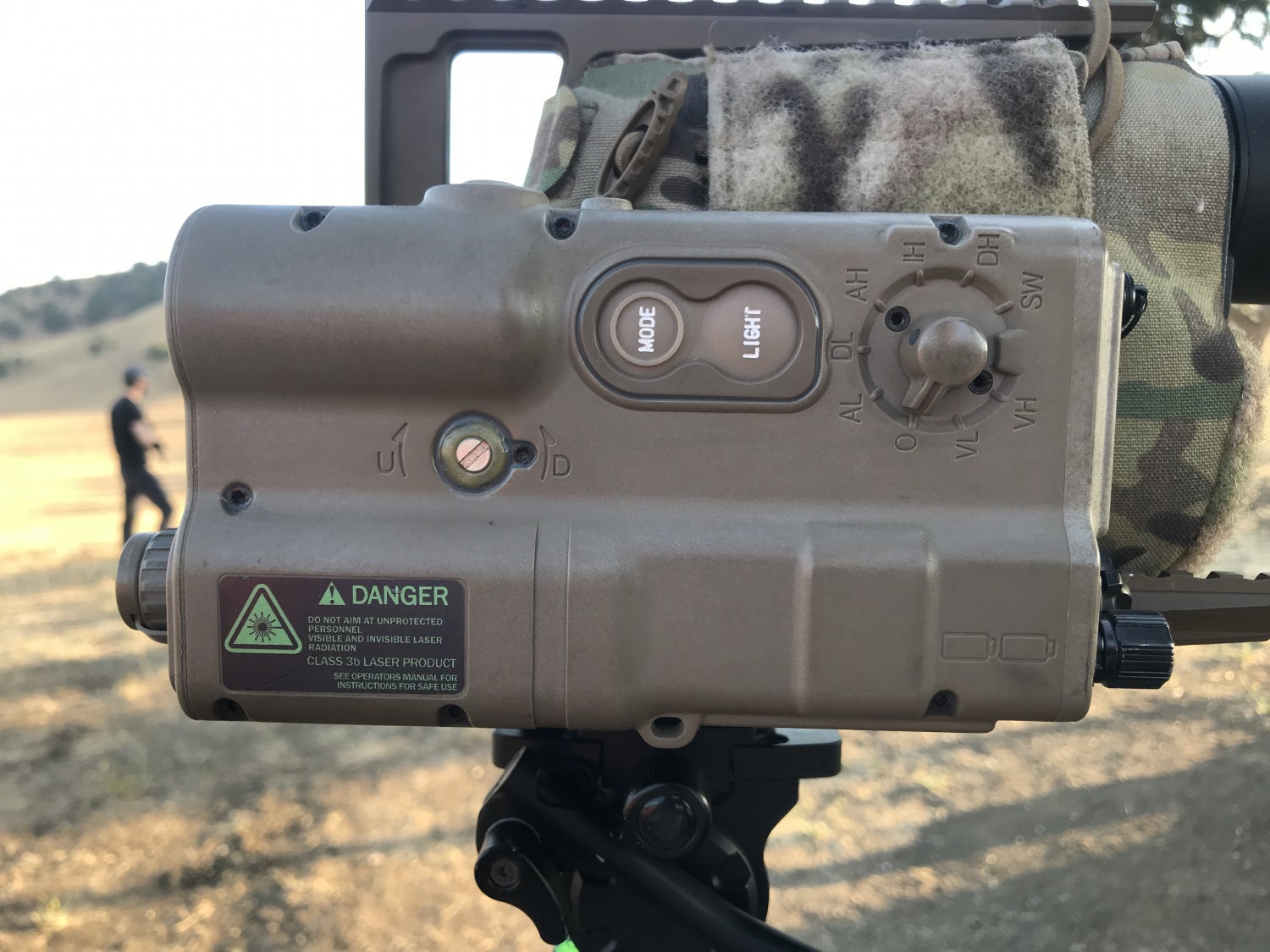
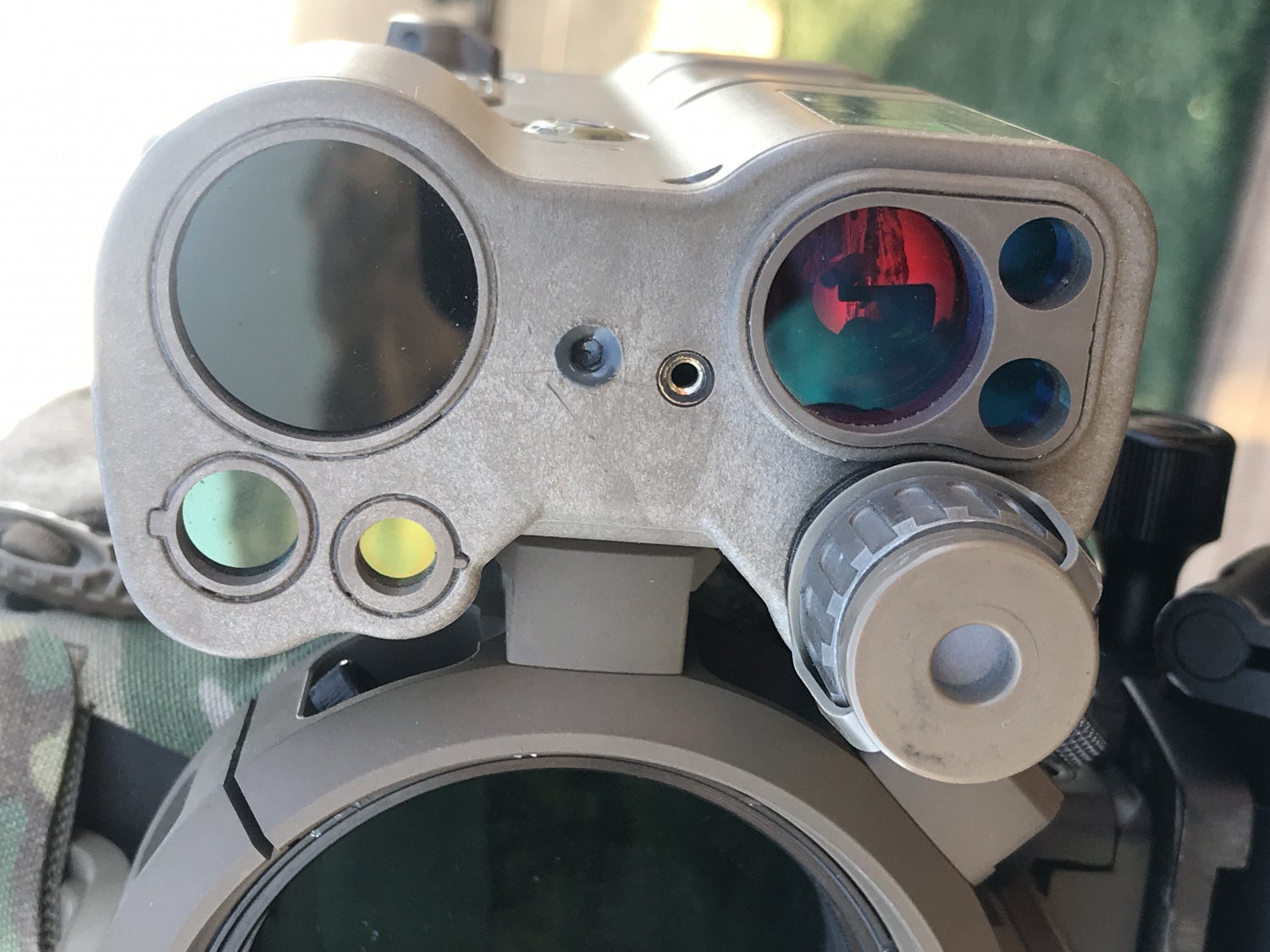

Kestrel
There is a 3D-printed holder that allows you to mount a Kestrel to a Picatinny rail. However, it sticks out like a sore thumb when you are trying to store your tricked-out spotting scope. My friend Vic found some 3D-printed GoPro hinges to go between the Kestrel mount and his spotting scope.
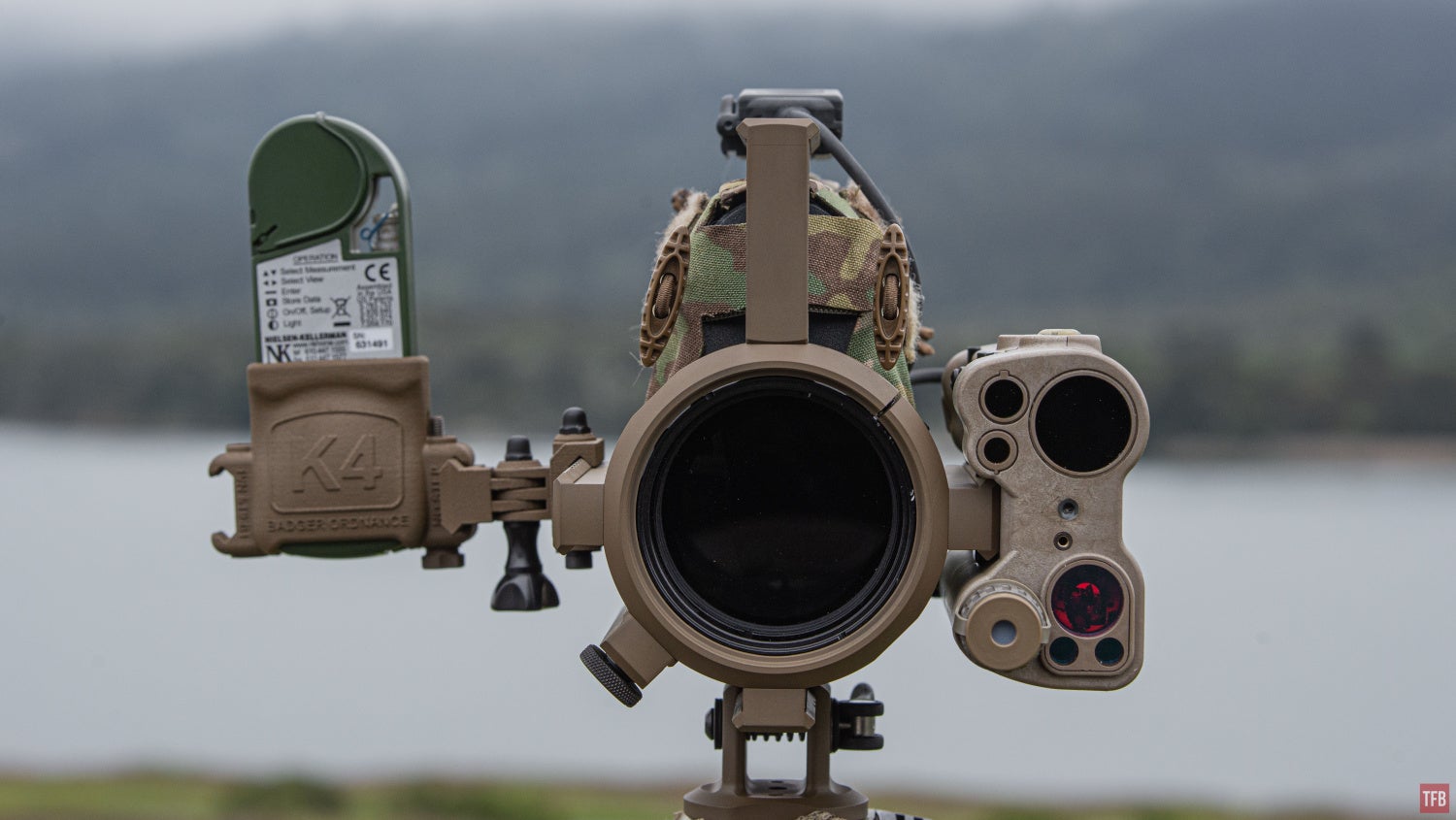

A red dot is rather useful so you can more quickly aim your spotting scope especially if they have high magnification. As long as you have spare rail space, slap a red dot. It does not even have to be a high-quality one since your spotting scope is not a firearm and you do not have to worry about recoil.
Illumination
IR illuminators are crucial for use with night vision clip-ons. I wrote about two long-range illuminators earlier. I found the Luna Optics ELIR is really hard to beat for the price and performance. Since that article, I discovered a simple hack to make the ELIR windage and elevation adjustments toolless. The plastic knurled head from my Lions Gear MACHOS is a perfect fit. They are M3-sized screws and you can order them from McMaster Carr. Now I can zero the ELIR on the fly without an Allen wrench.

Of course, you can use any other weapon-mounted laser illuminator but it will cost a lot more. And IR weapon light could work as well but not at long-range distances.
Thermal
If you are hunting, it is rather helpful to have a thermal device weapon sight on the spotting scope to help detect animals. Below I have the SIG Echo3 on my tricked-out spotting scope.

The Raytheon PAS-13E actually worked very well atop my Bushnell LMSS.


An animal about 500 yards away looking through the LMSS with PVS-30 and ELIR laser illuminator.

The same animal above but as seen through the Raytheon PAS-13E HWTS
My friend Vic runs a FLIR HISS on his Leupold. It is rather old technology and the resolution is not great but it is a cooled thermal sensor and it is very sensitive to heat. It can see the heat coming off a bullet as it flies through the air out to 700 yards. The FLIR HISS is a clip-on designed to be mounted in front of your day optic. Below you can see he mounted it in front of his spotting scope. He has since relocated it to the top of his spotting scope. This is due to the Badger Ordnance SLICK night vision rail. It does not sit below the objective lens but off to the side. While this is not an issue for night vision, the FLIR HISS has a rectangular screen/image and mounting it on the night vision rail cants the image. Another reason to mount the FLIR HISS is so he can still use a night vision clip-on. He has a PVS-26.

One of the biggest challenges for Vic was recording the thermal image from the FLIR HISS. After a long trial and error process, he figured out how to display the thermal image on a portable screen.
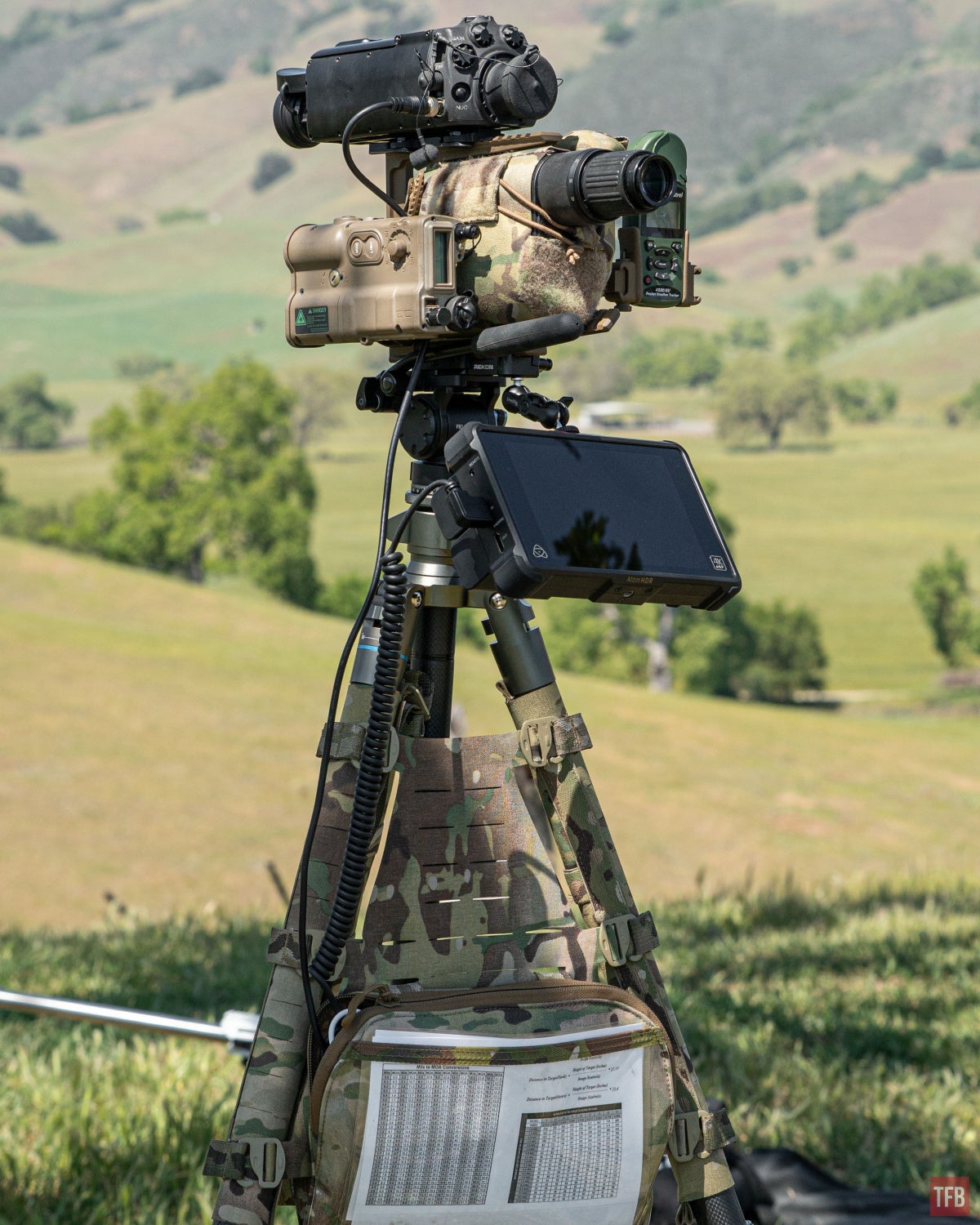
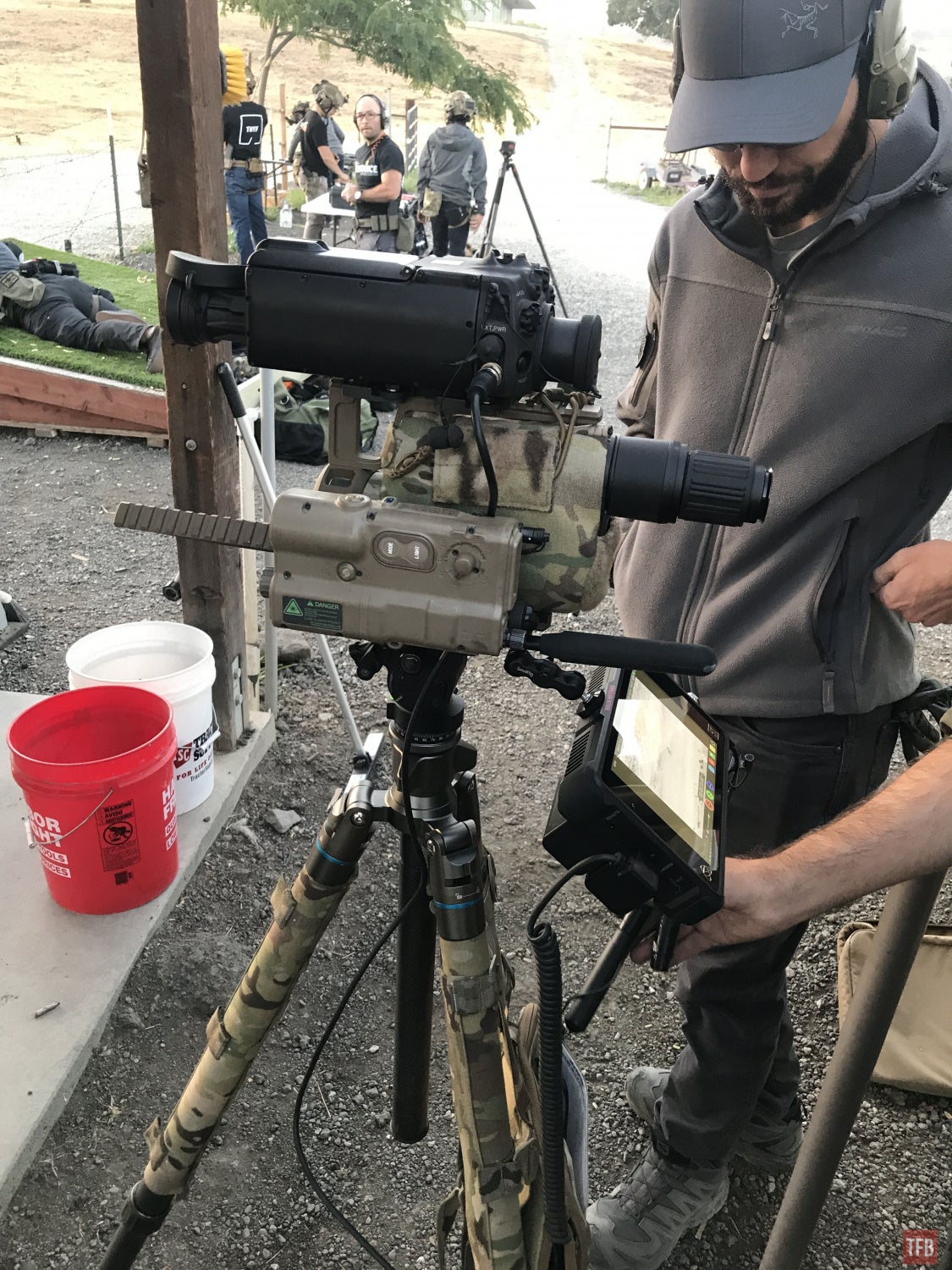
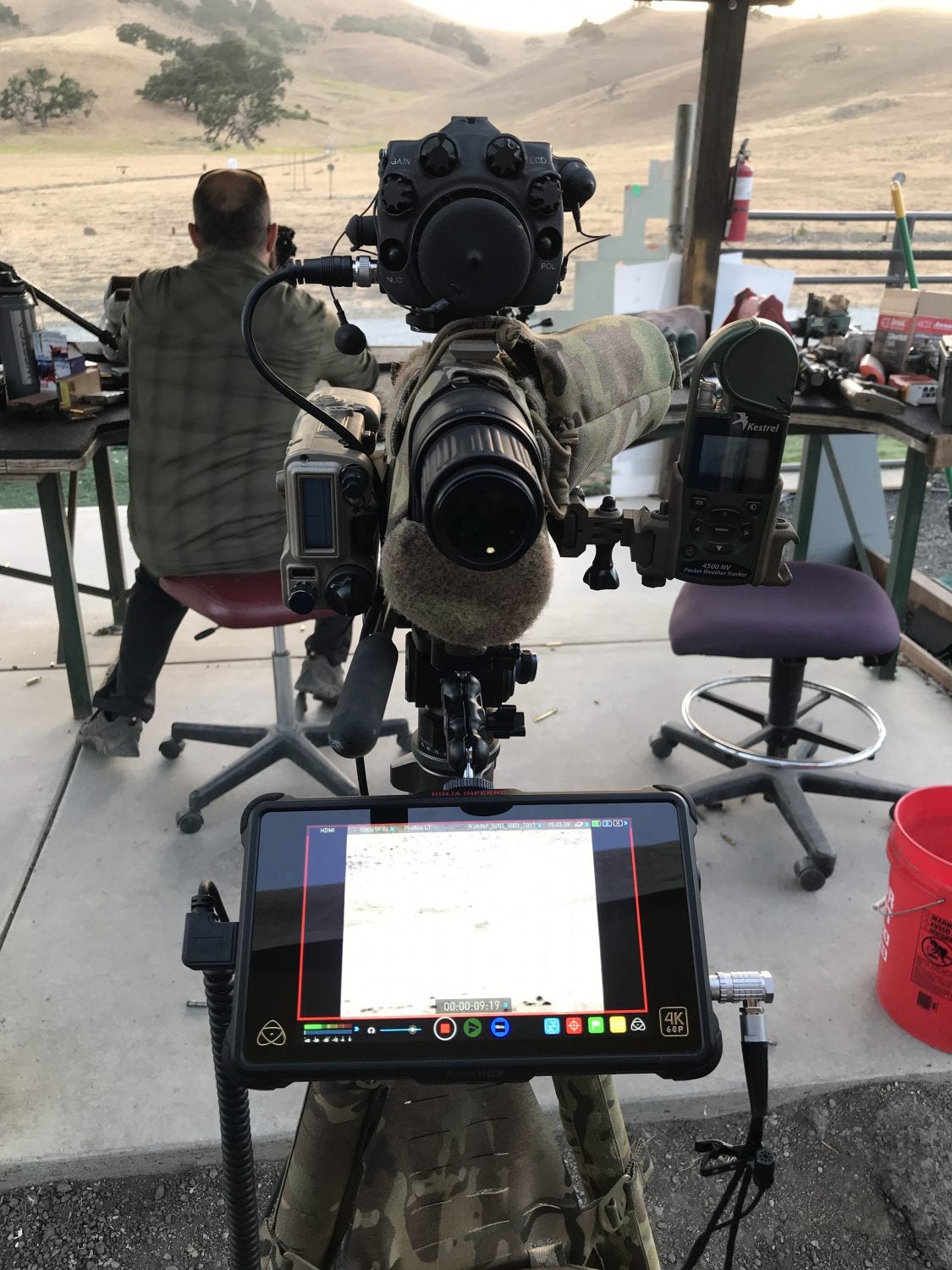
You can see a video of the FLIR HISS thermal on Vic’s Instagram account.
Night Vision Clip-On
Options for night vision are also limited. Whatever you can mount on your gun, you can mount on your tricked-out spotting scope. Remember I mentioned earlier how the Hensoldt is not as well suited for clip-ons? That is because most clip-ons are more suited for lower magnification like 10x. 15x is a bit too high. You can still see but you are now zooming in on the phosphor screen and the image is not as clear as it can be. The PVS-30, PVS-26, and PVS-27 are great. You can try using the CNVD-LR as well.

PVS-27 with Nocorium Multicam wrap
Other Tricked-Out Spotting Scope Accessories
My friend Kythe has this kill flash for his spotting scope. According to the manufacturer, Lirces, this is to help defeat peer-forces’ systems that look for reflections in objective lenses. It has a standard honeycomb kill flash but it also has an adjustable iris. The iris has two functions. Like a camera lens, the adjustable iris can increase the depth of field. You can see things a lot closer if you make the aperture small. This does restrict the amount of light so it does not work well at low light and you don’t really need to worry about this when you are using a night vision clip-on. The other benefit is it also reduces the objective lens’ ability to reflect light.
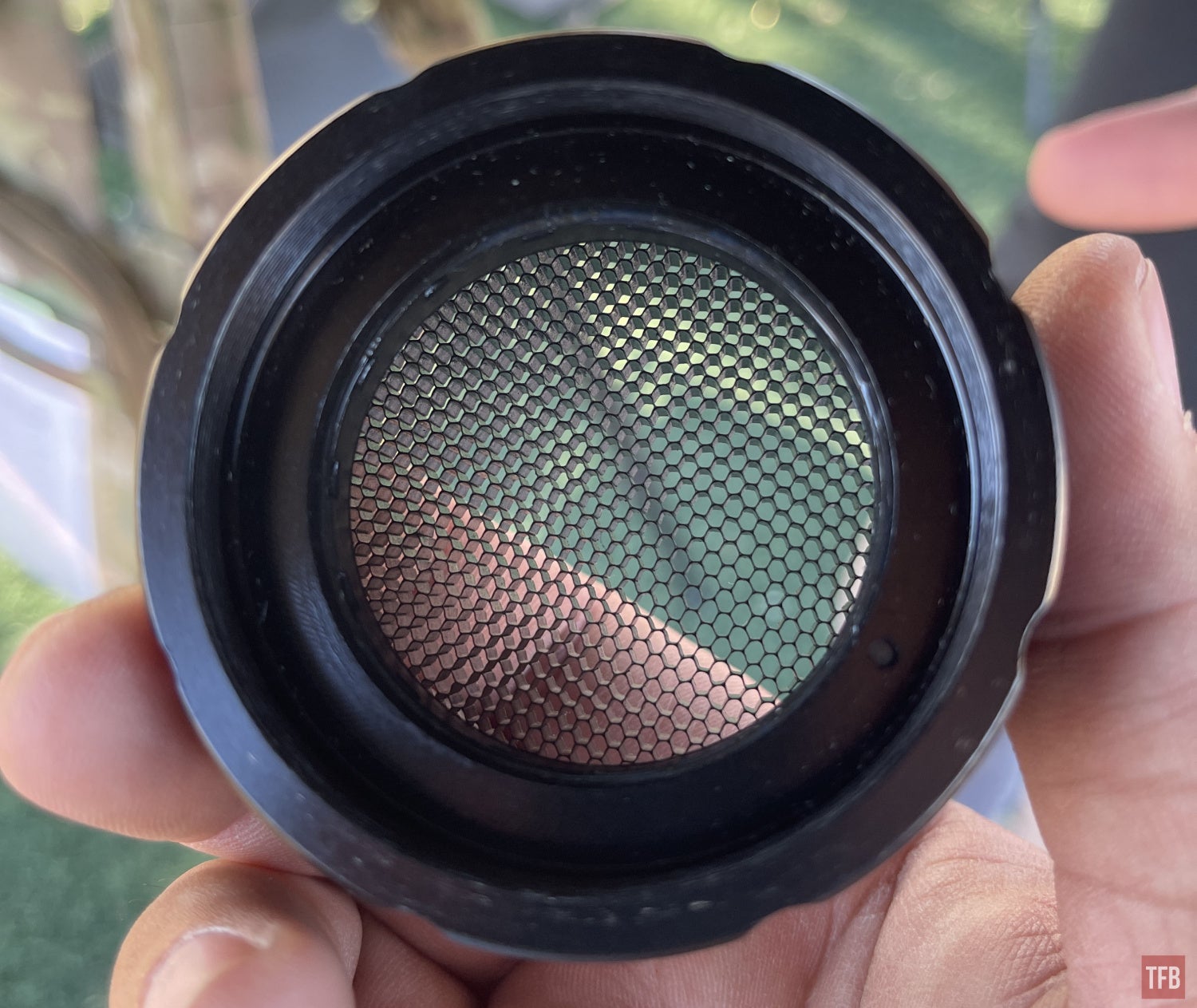
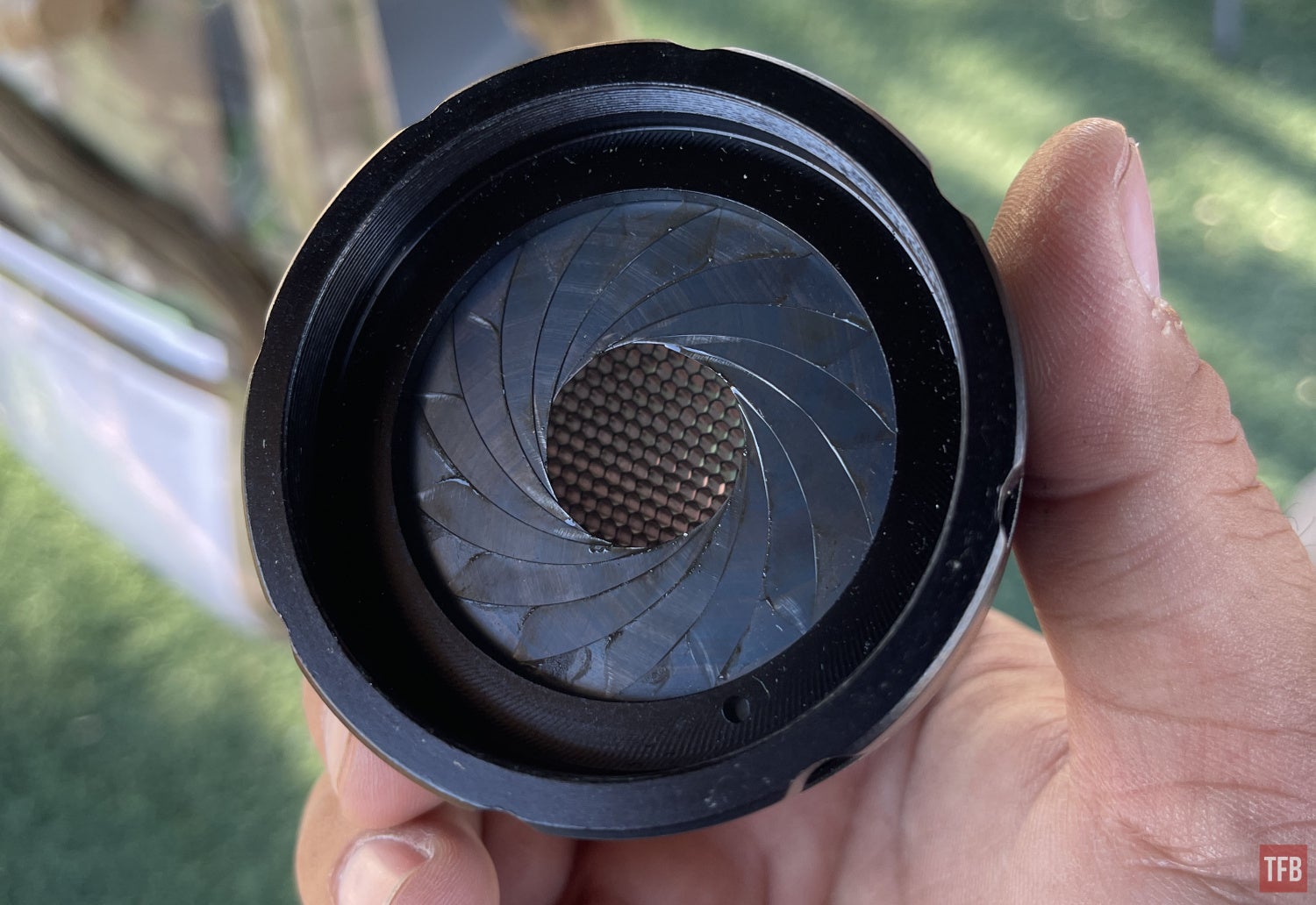

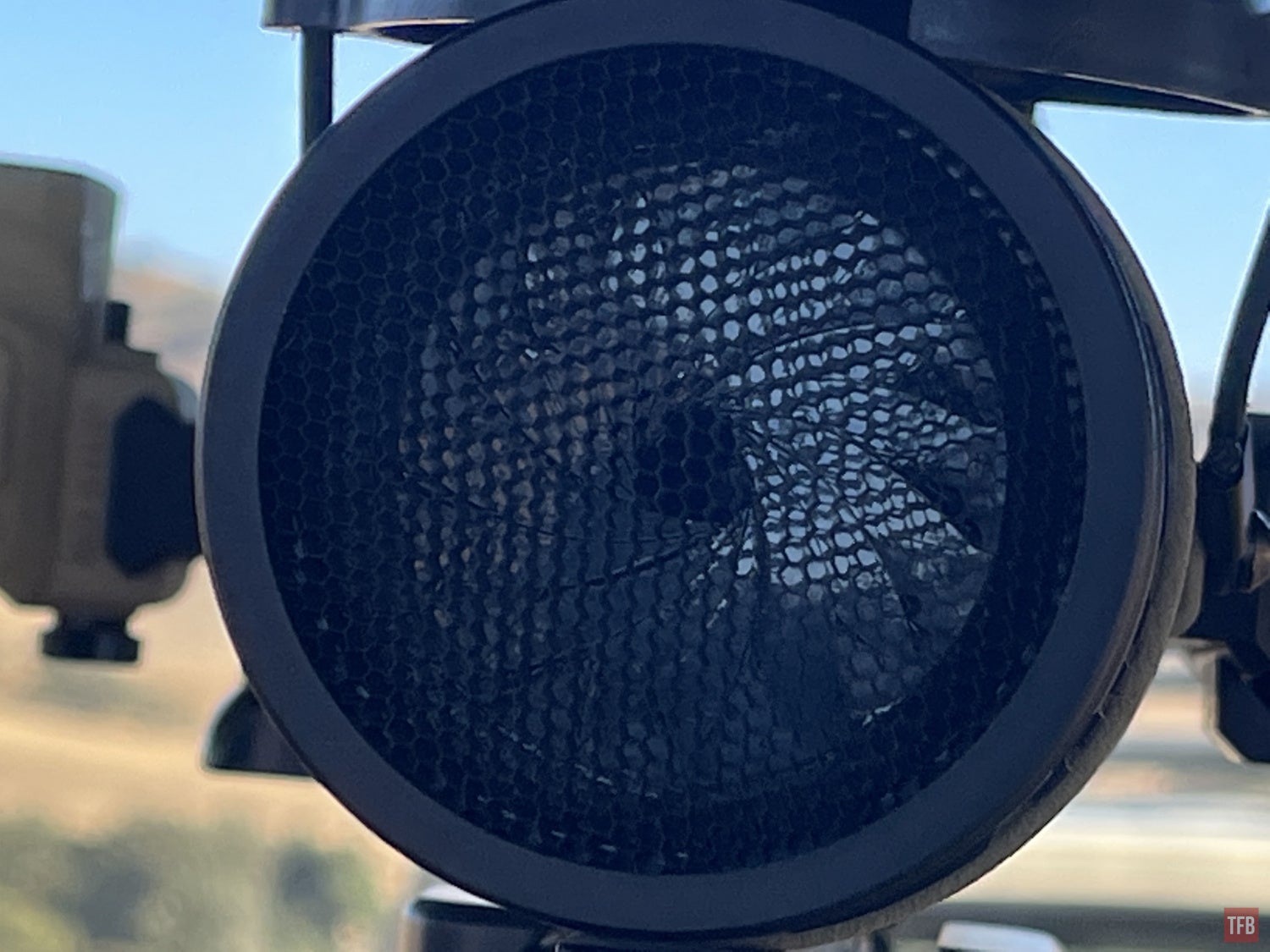
Echo Arms Pic-Fil-A sauce holder. For when you are spotting and are eating chicken nuggies. Where do you keep your sauce? On your tricked-out spotting scope of course.
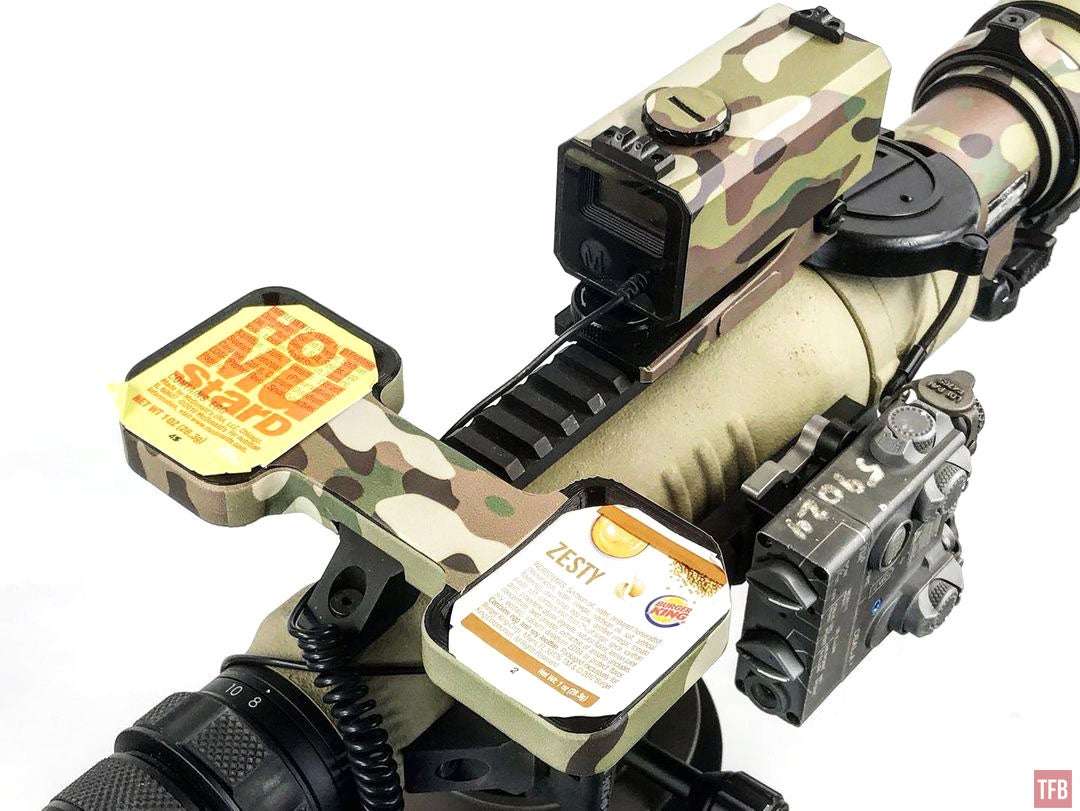
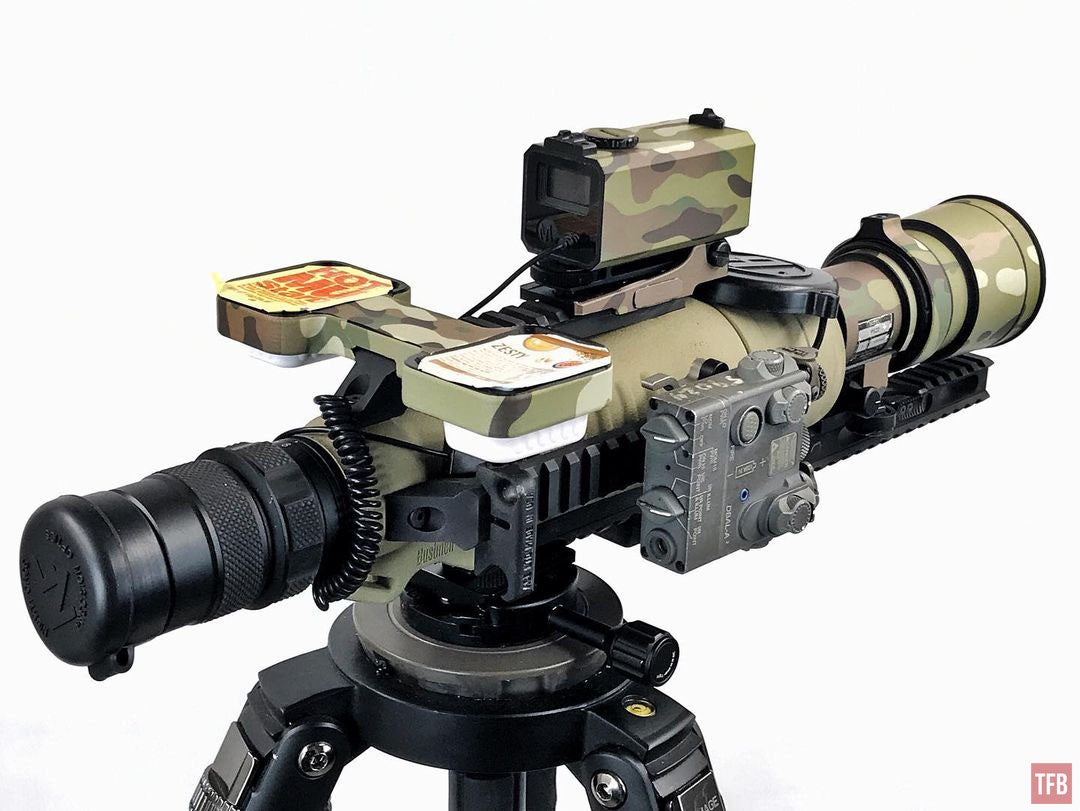
Spotting Scope Wrap Up
Nighttime observation is a different kind of fun and accessorizing your spotting scope to help see in the dark helps you achieve that. Setting up your tricked-out spotting scope is similar to equipping your firearm only finding ways to mount stuff is a bit more challenging. Hopefully, this article has helped or inspired you to set up a tricked-out spotting scope now.
TFB’s Friday Night Lights series is brought to you by ATN
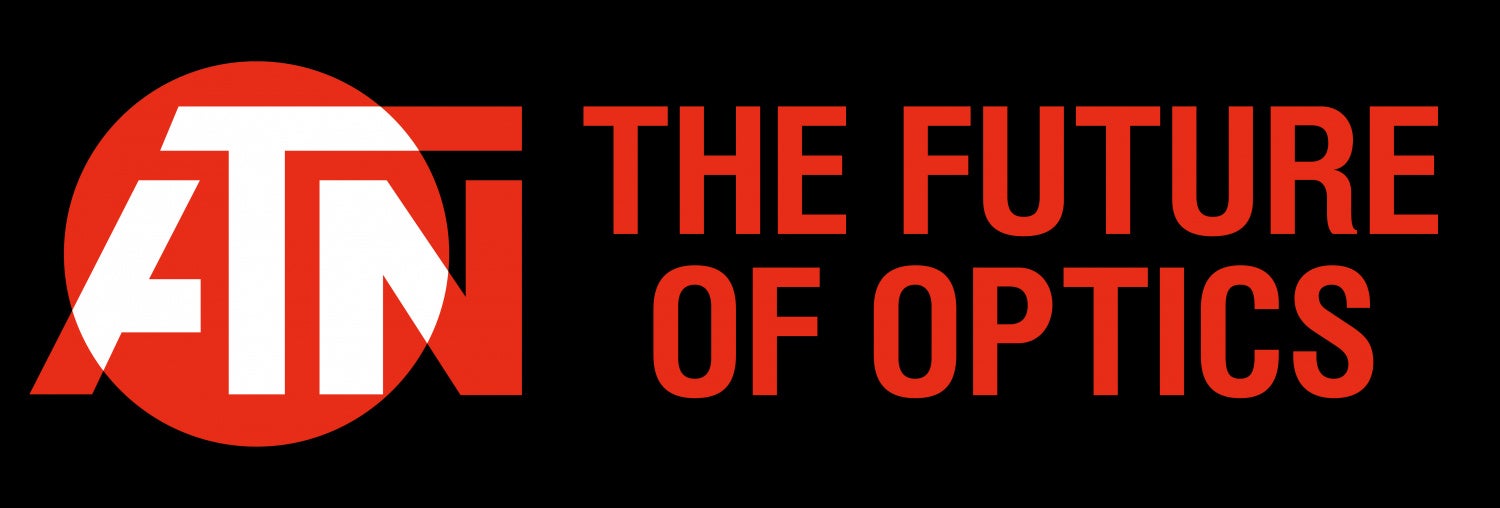
We are committed to finding, researching, and recommending the best products. We earn commissions from purchases you make using the retail links in our product reviews. Learn more about how this works.
 Your Privacy Choices
Your Privacy Choices
